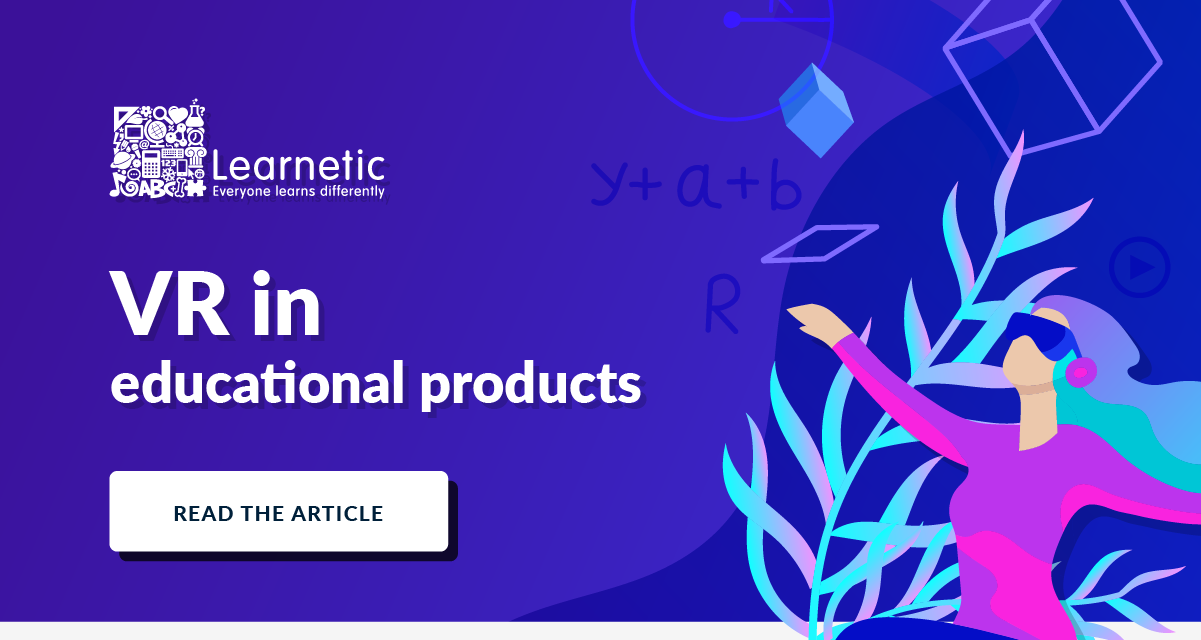Everything a publisher needs to know about Virtual Reality in education
Virtual Reality isn’t new. In fact, the term was first coined in the 1980s when goggles and gloves, which bear a striking similarity to today’s technology, were first developed. But it has also felt like ‘tomorrow’s technology’ for much of that time. That is finally changing and VR’s everyday usage is becoming increasingly common. In recent years, there has been significant uptake in areas such as gaming, architecture and medicine. VR in education is something that more and more educational institutions are looking to offer their students. When you look at the benefits VR can bring to teaching and learning, this is perhaps not surprising.
What exactly is VR in education and why do I need to incorporate it into my educational products?
VR uses near-eye 3D displays combined with pose tracking to make the user feel as if they have entered a virtual world. What the user sees changes with every move of their head – just as in the real world. By using specialist ‘gloves’ or controllers, the user’s hands are able to manipulate the virtual world around them.
This immersive experience can be used to create ways of learning that offer unprecedented levels of engagement. Increased engagement can lead to greater insights, heightened levels of motivation and a huge reduction in the number of incidents of disruption.
How is VR in education used?
The number of potential educational applications of VR is limited only by your imagination. Lessons that would never pass a health and safety risk assessment in the real world are everyday experiences in the virtual one. Fancy taking some geography students for a walk up a live volcano anyone? Not a problem.
Biology students will be able to dissect frogs, or any other animals, in ways that completely bypass ethical issues or actual harm to living things. Or they could walk around, step inside and modify molecular structures and DNA strands.
They could visit places where few humans have been. The bottom of the Mariana Trench, the International Space Station or the Moon’s Sea of Tranquility will be just a few clicks away.
And it doesn’t only have to be the extraordinary or inaccessible places that VR is used to visit. Virtual school excursions came into their own during the Covid 19 pandemic and it doesn’t look as if they are going away. When the American Alliance of Museums asked teachers if they were interested in continuing virtual field trips after lockdown restrictions were lifted, an incredible 95% said they were.
Virtual visits not only remove the cost and inconvenience of travel but also make all sites truly accessible to every learner. Medieval castles were specifically designed to make physical access as difficult as possible. They may have been reconfigured with tourists in mind but things such as narrow spiral staircases greatly restrict access to students who are also wheelchair users. There are no such obstacles in the virtual world.
The Educational Gains of Gamification
VR is now so established in the world of gaming, it makes complete sense to incorporate some of the most successful and engaging aspects of VR gaming into educational experiences.
Instead of merely visiting a medieval castle, why not set your students the task of attacking or defending one with the weaponry and technology of the time?
Rather than being a passive observer of what a natural disaster might be like, set them the challenge of trying to mitigate its effects. That way, they could find out for themselves which are the most effective – and least effective – options. And, perhaps more importantly, gain a deeper understanding of the reasons why.
Creating educational content for the VR world
It is important to understand that creating content for the Virtual World doesn’t mean you have to start from scratch. Your current resources can also be enhanced to incorporate 3D models instead of 2D diagrams and upgraded to include various VR features.
All of your existing eContent, even if it is not VR, can be placed within a VR environment. From there, learners will be able to access it through their avatars.
Which VR education platform should you choose?
The things described above aren’t the possibilities of the future. Many of them already exist and the technology is there for you to incorporate all of them into your products today.
Learnetic’s mCourser Learning Management System (LMS) has been built from the bottom up with cutting-edge technologies, immersive VR and AI tutoring in mind. When using mCourser, students can enter a fully customisable virtual lobby. From there, just like in the lobby of their actual school, they choose the appropriate room for their studies that day.
That might be embarking on a virtual field trip or entering a VR classroom in order to join lessons and presentations being led by teachers.
It could involve entering private chat or study rooms where collaborative screens enable students to work together to solve problems and engage independently of their teacher. Or it could involve seeking help from the AI Personal Teaching Assistant.
Full content access is available from the lobby and, whichever option the student chooses, everything will be experienced in real-time through their avatar.
What specialist equipment does VR in education require?
Many educational publishers mistakenly believe that the cost of the hardware needed to incorporate VR into teaching is prohibitively expensive for many centres. They are therefore reluctant to develop resources that relatively few establishments will be able to afford to access.
Admittedly, options such as the Apple Vision Pro and the Meta Quest 3 are at the pricier end of the spectrum and perhaps beyond many schools’ budgets. However, this is not the only VR option. Cardboard goggles which allow phones to be slotted in are available at just a fraction of the price and still enable students to access VR content. In fact, cardboard goggles could be completely free if you’ve got the skills and patience to make them yourself!





